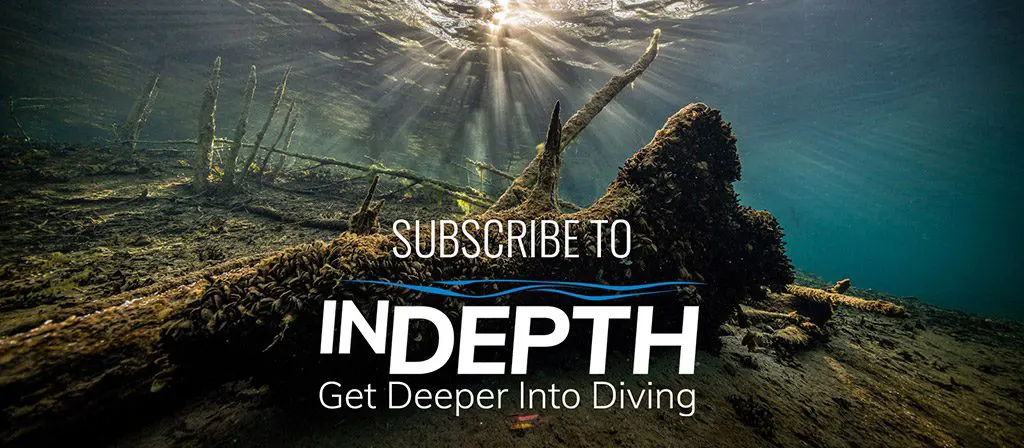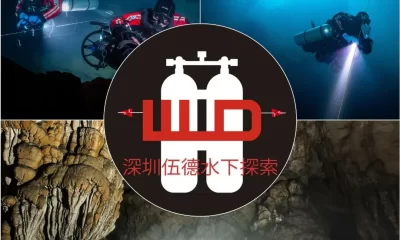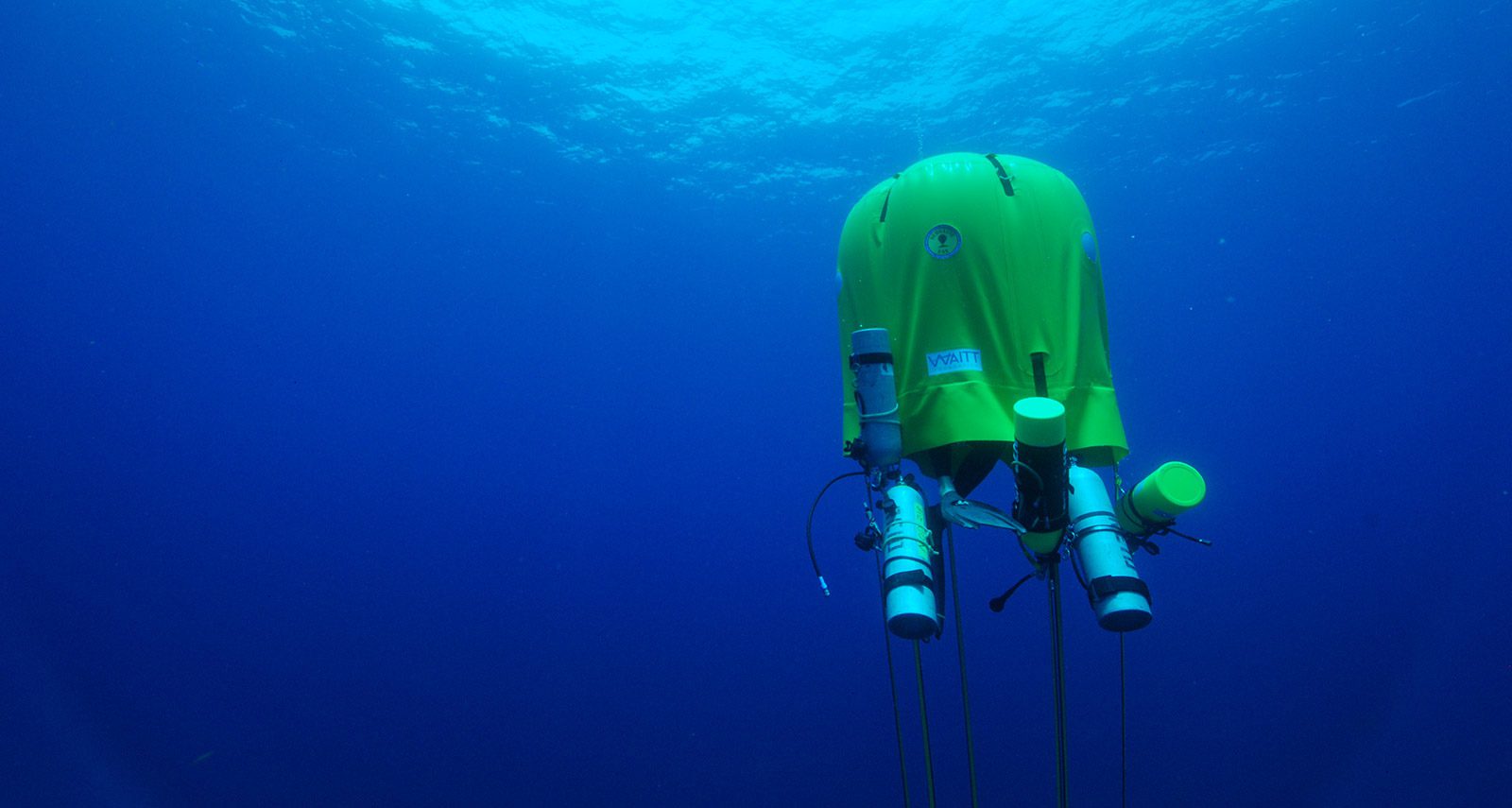
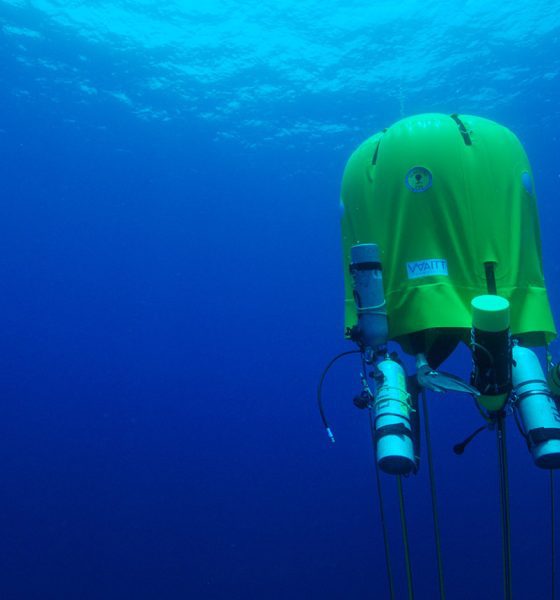
Latest Features
Portable Habitats: New Technical Diving Capabilities are Well Within Reach
Portable habitats aren’t only for cave diving. They have long been a dream of undersea technologists like Michael Lombardi, whose ocean space habitats were used during Discovery Channel’s Shark Week. He compares the habit experience to “camping in the woods overnight versus taking a short hike in the park,” and believes the “sweet spot” for underwater habitation is directly ahead of us. Tune in, turn on, drop down.
by Michael Lombardi. Lead image: The author’s Gen 1 Ocean Space Habitat deployed in openwater to support decompression after deep 400+ foot scientific dives. Image by M. Lombardi, courtesy National Geographic Society/Waitt Grants Program.
In June–July 1964, Ed Link, a businessman, inventor, and philanthropist, conducted his second Man-in-the-Sea experiment in the Berry Islands (a chain in the Bahamas) with Robert Sténuit and Jon Lindbergh, one of the sons of Charles Lindbergh. Sténuit and Lindbergh stayed in Link’s SPID habitat (Submersible, Portable, Inflatable Dwelling) for 49 hours underwater at a depth of 432 ft/132 m, breathing a heliox.
The SPID, as the name implies, was a portable inflatable habitat, and was among the several projects through the 1960’s and 1970’s aimed at affording more efficient and effective manned diving operations via new techniques in saturation diving out in the deep oilfields, and also to serve as proxies for the space race. Even today, that bold dive sounds like something out of science fiction and leaves one to ponder where the dream of undersea habitation may take us in the future.
Underlying these ambitious initiatives, over 50 years ago, was the shared vision—among many, but not all—of making the technology accessible to diving scientists such that the ocean could be studied by people who were essentially part of the environment rather than temporary visitors. Several habitats dedicated to science came and went through that period and into the early 1980’s, with the last standing today being the Aquarius Reef Base, and the Jules Undersea Lodge, both in the Florida Keys. They have much in common—primarily that they are fixed ‘permanent’ structures— meaning that their operations are limited to their current deployment locations. Both are symbolically important platforms that remain relevant to afford science and education opportunities.–Most notably, in recent years, was Bruce Cantrell and Jessica Fain’s 2014 ‘Classroom Under The Sea’ project in which they resided within the Jules Habitat for 73 days, a true testament to human endurance beneath the sea.
These two permanent habitats also illustrate several challenges; first and foremost is the operational expense. Sadly, field marine science today operates very, very lean. There are no huge budgets that afford large field teams to spend weeks to months immersed in the underwater environment using even conventional scuba. Some scientists will tell you that “the basic ecology type studies are done.” This was the work that required the careful eye of the scientist to be there, on site, and in the environment for lengthy periods of time. I, for one, don’t believe that for a second, and have personally seen and done things that no robot could do at depth (such as the discovery of a highly cryptic new species of fish Derilissus lombardii).
My belief is that the dismissive perspective is the result of the science community simply not having routine or affordable access to the environments in question. There are massive swaths of deeper depths, within range of modern technical diving, that no person has ever set sights on—primarily because the effort to get there is perceived as too technically challenging and too expensive [or rather not cost-effective]— relative to the return.
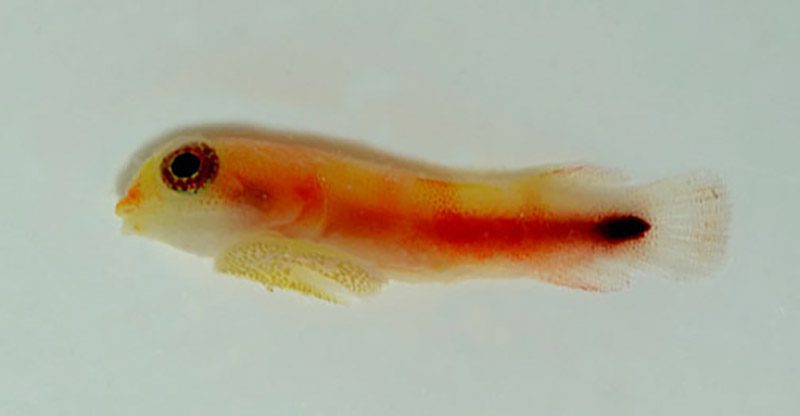
Where Does That Leave Undersea Habitation Today?
Today, the most cost-effective means for long duration undersea habitation is the technique called ‘saturation diving’, all evolving from the aforementioned golden era of the 1960s and 1970s to specifically meet the call of industry, with first applications in the offshore oilfields, and then more recently inshore within freshwater aqueducts and other specialized circumstances. This mode of diving involves the use of mobile diving bells, often deployed from a ‘saturation vessel/ship or barge’, where the divers remain under pressure in a deck chamber, and transit to/from depth in a bell. This is done for safety reasons and to allow the vessel to remain mobile and transit to the next work location without waiting for the divers to return from lengthy decompression. This mobility is important to cost effectively move project to project, and it’s an equally important concept for a scientist who wants access to varied geography—something that fixed, stationary habitats do not provide.
Common to modern saturation diving, and the permanent science habitats, are relative comforts. –Both allow for a decent meal at the end of the day, a place to catch some sleep, afford some workspace, and atmospheric and environmental regulation to make the uncomfortable stay as comfortable as possible. To accommodate all of this—for days or even weeks—requires lots and lots of topside support and infrastructure. That means it’s an expensive proposition, and the end has to justify the means—industry can sustain this if and when the job warrants it—science, on its own, cannot.
Ed Link’s SPID always resonated with me: the idea of being portable by making the habitat structure itself a lightweight inflatable shell or envelope, with the balance of equipment required being relatively modular. The herculean effort to spend 49 hours at a depth of 432 feet is still unfathomable. That was more than 50 years ago, and not much that is related has been done since.
Where did it go? Why did it disappear?
I can speculate that a few issues came to play; one being diver comfort at depth, in the cold, and without the comforting support of today’s saturation diving spreads. This is totally understandable. Two being safety; those guys were as out there on their own as you can get which can very quickly turn the stomach of a seasoned 21st century dive safety professional or risk manager, also very understandable.
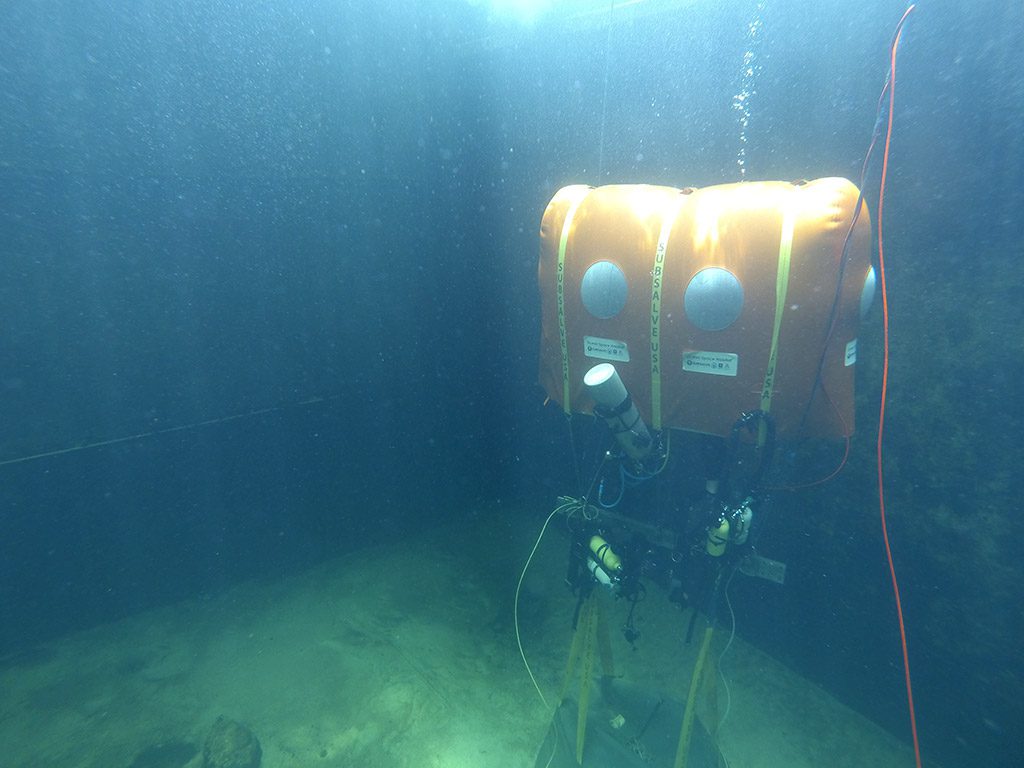
Portable Habitats to Augment Decompression
Since 1964, portable habitats were revisited a few times, principally in the cave diving community, as more modernized techniques in technical diving allowed ambitious surface-to-surface decompression dives to be carried out. This means saturation at depth is avoided, and the divers commit to desaturating on the single dive before surfacing. With the longest required decompression stops being in the shallows and requiring multiple hours to even a day of decompression, revisiting portable inflatable habitat technology became a demonstrated need. Perhaps most notably was Bill Stone’s Wakulla Project. Similar efforts have taken place since, all principally in caves in large part given that small habitat structures can be wedged into the ceiling of the cave to maintain its position. That raises the biggest challenge with the technology – ballast and anchoring.
Recent Directions With Ocean Space Habitat Technology
In my own work, which is in non-cave environments, I’ve realized the depth and duration boundaries while working in excess of 400 feet on mesophotic coral reefs – that warranted a close look at the need for a decompression habitat, and the value was plain as day. Our first use was in 2012 as a captsone demonstration with support from the National Geographic Society and Subsalve USA, we built up the Gen 1 ‘Ocean Space Habitat’ as a decompression station resting between 20 and 30 feet of water. Quite simply, this first deployment shed light on the concept of making productive use of otherwise unproductive time.
When we consider the effort for a mainstream mixed-gas technical dive— while it’s gotten easier over the last two decades, particularly with rebreathers—there is considerable question as to whether or not 10-45 minutes of bottom time at the expense of multiple hours of decompression is worth it. There’s no getting around the fact that hanging on a line for hours upon hours is miserable. So, our Gen 1 Ocean Space Habitat was simply about adding a level of comfort, though so much more became evident.
The 2012 project got us thinking seriously about enhanced capabilities while maintaining full system mobility, though while separating the issue of ballast and anchoring as an integral component that also must be portable. Even a modest-sized structure that can accommodate two people exerts substantial buoyant force of several thousands of pounds, and this needs to be managed safely.
Concepts in managing large buoyancy volumes and life-critical rigging have carried over from my career in commercial diving and marine construction. To date, we’ve deployed portable habitats using a variety of anchoring techniques including drilling and epoxying pins into substrate, setting dead weights, hydraulically installing helical anchors, and even beneath floating structures using inverted scaffolding. The anchoring strategy is always location/environment specific, and can be achieved with nominal investment. Perhaps someday we’ll have strategically pre-deployed habitat ballast at sites of interest, and can simply move location to location with the portable system in tow, prepared to set up ‘camp’.
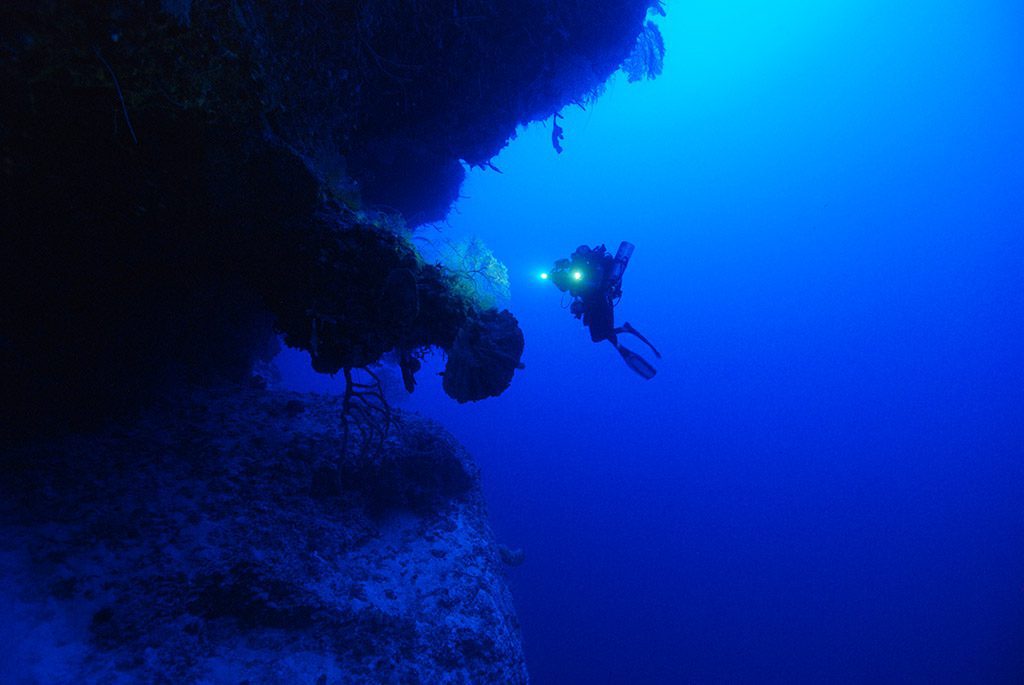
We’ve continued to incrementally address several challenges with portable habitats, all with an eye on making them more widely available for a variety of purposes. In 2015, in cooperation with the City University of Hong Kong, we deployed a system near the remote fishing village off of Kat O Island where the habitat occupants could simply sit among the aquaculture pen and observe as an integral part of the system. We cycled several students through the habitat to have the unique experience, and also teach them about principles in atmospheric management within this confined space. For this evolution, we incorporated a purpose-built rebreather for atmospheric management. While challenging, given the language barrier, what was reassuring to me was that principles in rebreather use had become simple enough over the last 20 years, so this information could be distilled to a very basic level. I realized that while portable habitats had established utility for decompression, they may well be simple enough for more mainstream non-technical use.
We followed that critical demonstration with some fine tuning of the habitat life support, and in cooperation with New York University, went on to be awarded a patent in 2018 entitled ‘Portable Inflatable Habitat with Modular Payload, System and Method’.
Current Activities
Over the last few years we’ve carefully considered the work from the last half a century, and we believe there is a niche emerging to make use of this portable inflatable habitat technology in a more widespread way. This very well may be the ticket to more routinely afford science with the life-in- the-sea capabilities dreamed about so long ago. The sweet spot isn’t ‘saturation’ per se; that requires creature comforts and costly infrastructure. It also is not ‘decompression’; that’s a need for only the most experienced technical divers. For the average diving scientist or enthusiast, it’s about a newly immersive experience and the gift of time in the water.
Deployed in very shallow water, say 7 to 9 meters/20 or 30 feet, where no decompression limits are virtually infinite, portable habitats simply provide space – space to work, space to rest, space to interact, space to observe – and afford time. According to American Academy of Underwater Sciences (AAUS) statistics, the average scientific dive is about 45 minutes in length. That means that virtually all marine science data and observations made by divers being there todate have been made within these little snapshots of time, and only those fortunate to have deeper pockets have been granted improved access with more sophisticated techniques. By simplifying the application of habitats to shallow water, and leveraging tools and techniques that are becoming more and more familiar (rebreathers), that are readily available and understood in today’s technical diving community, cost-effective diving excursions can reach a full day, overnight, or potentially several days with both limited infrastructure and overhead costs. It’s not about depth or duration necessarily; it’s about the newly appreciating human value from the immersive experience.
This changes the game.
For perspective, I like the camping analogy – we certainly learn more from an overnight in the woods than we do a short walk through the park. Until now, we haven’t had that opportunity, and it’s one that is so very important. Humanizing marine science means that the diver can become a more effective and important tool for the job. We’ll see things we’ve never seen, have interactions we’ve never had, and catalyze renewed understandings of how ocean systems work – all by becoming part of the system.
This was very well illustrated by Dr. Tristan Guttridge and James Glancy during their recent (2021) work on Andros with hammerhead sharks, which was featured on Shark Week. We deployed a recent generation, portable habitat in 7 m/20 ft of water in proximity to a number of environments of interest that Dr. Guttridge wanted to visit and observe all during one tidal cycle to learn more about hammerhead sharks in the region. Divers entered the water around 2 AM using standard open-circuit diving equipment and conducted multiple excursions all within recreational dive limits from the habitat over a ten-hour period, without surfacing.
Multiple multi-level dives were made, all without incurring decompression prior to returning to the habitat, and then, when surfacing 10 hours later, their computers were clear. This effort was rather revealing – first, it served to prove out that our technology and system itself are viable. Second, it demonstrated that full-day underwater experiences can be had without undue decompression stress, and third that the ‘gift of time’ promised from early undersea habitation may be within reach in a cost-effective way.
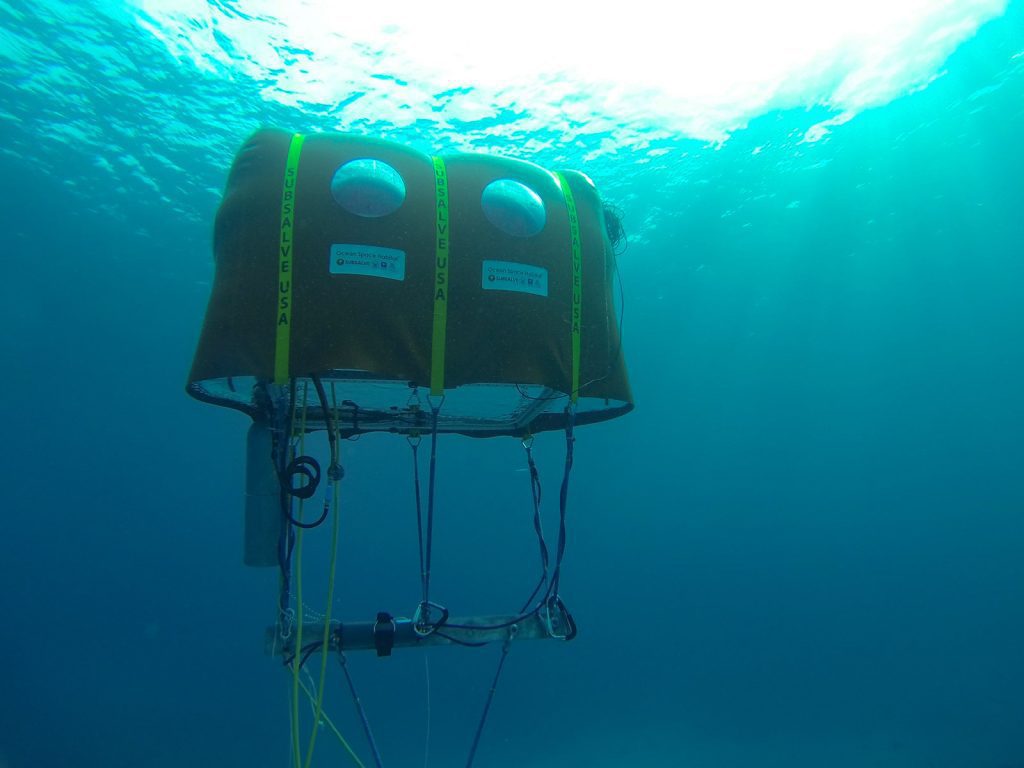
From a decompression standpoint, rebreathers and technical diving have always been about reducing our decompression obligation to get the diver out of the water as quickly but safely as possible. That’s been an okay perspective but does little to truly capitalize on rebreather technology. In most cases, we have four to six hours of life support on our back. If none of that were needed for decompression, and we were then dependent on a small habitat to decompress overnight or take a break mid-day, we would have more time to be immersed in the environment, allowing us to carry out the tasks at hand. We could make use of otherwise wet time, hanging on a line for other productivity—processing samples or imagery, having a bite to eat, watching a movie, taking a nap, even.
When time is on our side and there’s no shortage of it, why rush to get out of the water? By lowering PO2s to ranges where oxygen toxicity is less concerning for long exposures, we have no shortage of time. From the nitrogen standpoint, so long as the habitat nitrogen partial pressure is less than or equal to surface nitrogen pressure, theoretically there is no decompression penalty to extensive stays in very shallow water, and we can come and go freely with the habitat becoming the new surface.
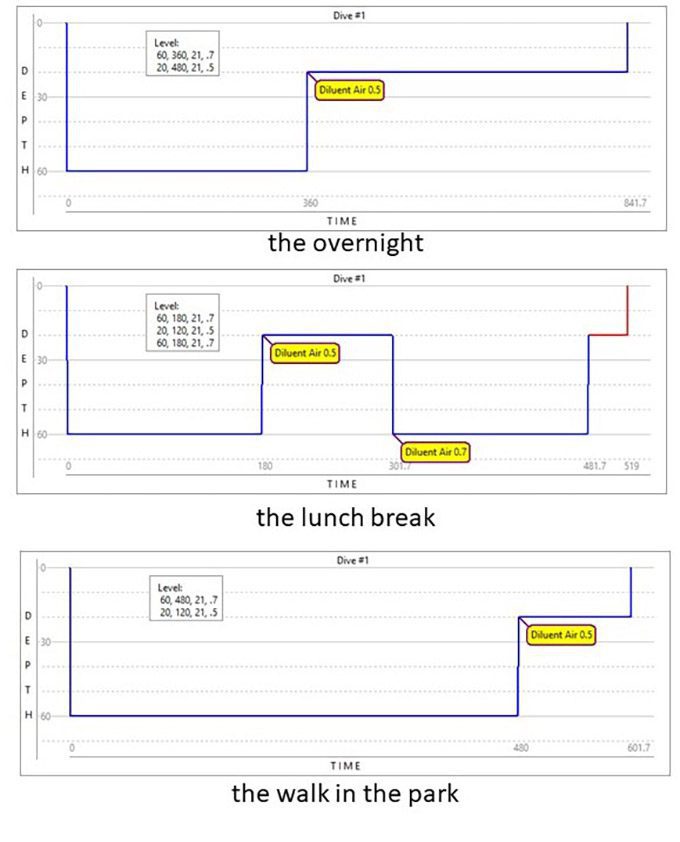
The capability is very real, attainable, and has been proven out, though we still have an open question of how portable habitation might impact day-to-day operational footprints or constraints. For example, is there a cost-benefit to adding some complexity to afford a vastly longer immersive experience versus sticking to the status quo of short experiences? Our team has just recently begun to address this question with work at the University of Arizona’s Biosphere2 facility. Biosphere2 was purpose-built to study enclosed environments, sustainability, and how humans function within these closed systems with an eye on future human initiatives on Mars or elsewhere, so we are thrilled to be undertaking similar work within the Biosphere2’s ‘ocean’. To date, we’ve deployed a few iterations of our Ocean Space Habitat within the Biosphere to evaluate hardware and technical improvements, and also to begin gathering very early data with DAN Research related to cognitive performance and stress of the habitat occupants. As the project continues, we expect to carefully assess what a small team can achieve within a 24-72 hour stay. This would be while leveraging things like consumer electronics, advances in scrubber chemistry, and while establishing simple but reliable system use protocols that make dives of this duration within routine reach for today’s ‘technical diver’.
Future Directions
Undersea habitation, while ‘cool’ in concept, requires a demonstrated need to become viable. Exploration of this question with simple, low-cost, portable habitats will be the path to understanding if larger, permanent structures might become useful in the future. For example, now that we have this gift of time that is potentially accessible to large populations, can the time be used to improve our understanding of the ocean across environments around the world? And then, is the effort more cost-effective than alternative intervention strategies? Embracing ‘citizen scientists’ will be mission critical.
We can continue to explore for the sake of exploring, although it’s the discovery of a market opportunity attracting industry that makes new capabilities sustainable. As much as it saddens me, to date there is just no need to put people on the seafloor semi-permanently, outside of oil and gas and municipal infrastructure service work. If there were, we’d have no shortage of habitats. Of recent concepts proposed, I think Phil Nuytten’s Vent Base Alpha—while still space-age—is the most practical. This model suggests that a one-atmosphere habitat might be placed alongside a hydrothermal vent, The energy from the vent would power the habitat, and the personnel would be there in support of deep-sea mining.
This only works if 1) there are long term tasks to conduct that require humans on site such as robotic vehicle maintenance 2) the operation is more cost effective than maintaining a surface vessel and making multiple seafloor transits to conduct the same tasks while proven out to be safe, and 3) if the environmentalists agree that deep sea mining is an acceptable alternative to fossil fuel independence and can be done responsibly.
Progress means moving forward and finding—then filling—the niche. In the case of underwater habitation, it’s taken 50 years of very literal ups and downs, but I’m confident that the sweet spot is not ancient history—it’s in front of us; it’s simple, palatable thanks to rebreathers, affordable and well within our reach. What’s more it’s something we can all participate in to help justify the value proposition of putting people beneath the sea. Think of it as an underwater camping trip.
Dive Deeper
Alert Diver: Michael Lombardi: Immersed in Science By Madeline Coombs and Frauke Tillmans, PhD
Living and Working in the Sea by James W. Miller and Ian G. Koblick
NatGeo: New ‘tent’ makes it possible to camp underwater. New submersible “tent” lets divers nap, eat, and decompress beneath the waves
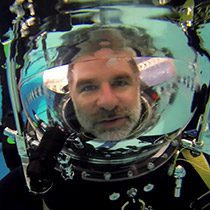
Michael Lombardi is a Rhode Island, USA- based diving contractor, inventor, and entrepreneur. He has amassed more than 5000 working dives in extremely challenging conditions ranging from inshore marine construction to deep mesophotic coral reefs. He Co-Chairs the Marine Technology Society’s Diving Committee and is widely published in the field. His company designs and builds closed circuit rebreathers, CCTV systems, portable habitats, specimen collectors, and recently medical device appurtenances for respiratory and hyperbaric applications. His work on portable habitats has been funded by the National Geographic Society, and recently featured on Discovery Channel’s Shark Week. His favorite undersea creature is the mesophotic clingfish bearing his namesake, Derilissus lombardii, which is reposited at the American Museum of Natural History. More on Lombardi Undersea LLC can be found at www.lombardiundersea.com. Michael’s work in the community can be found at www.oceanopportunity.com. His email is: [email protected]



















